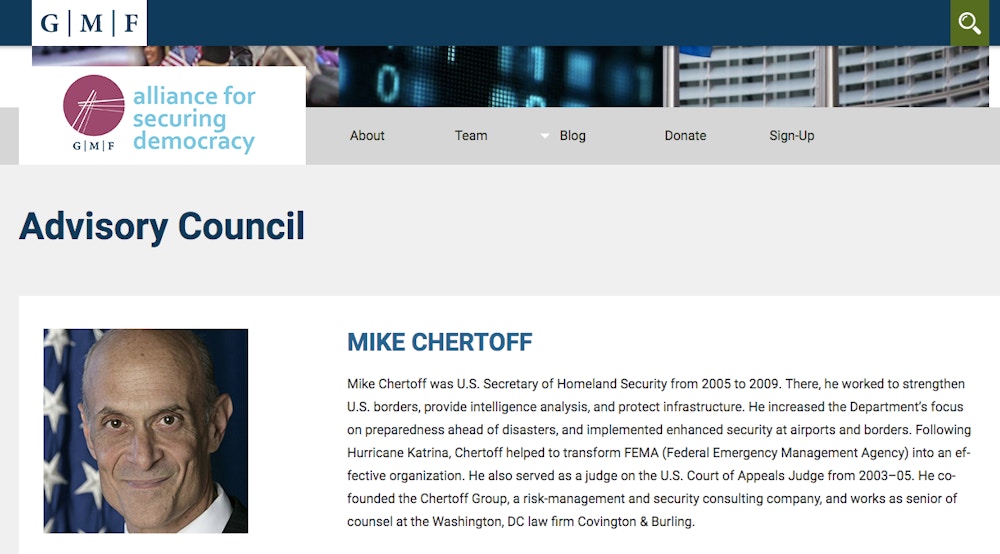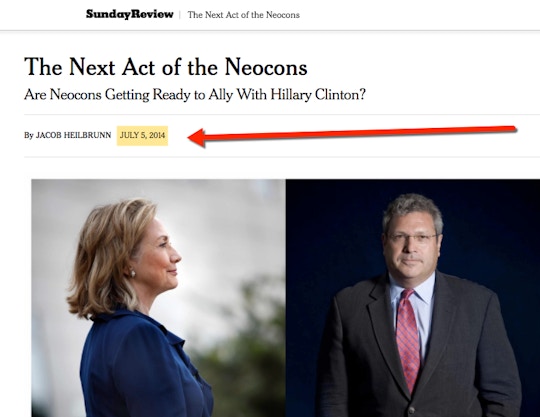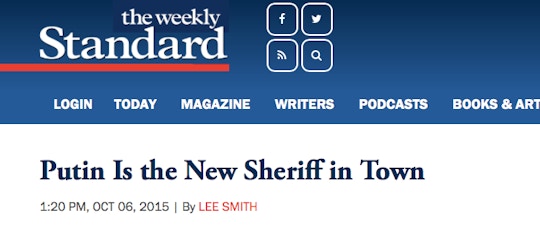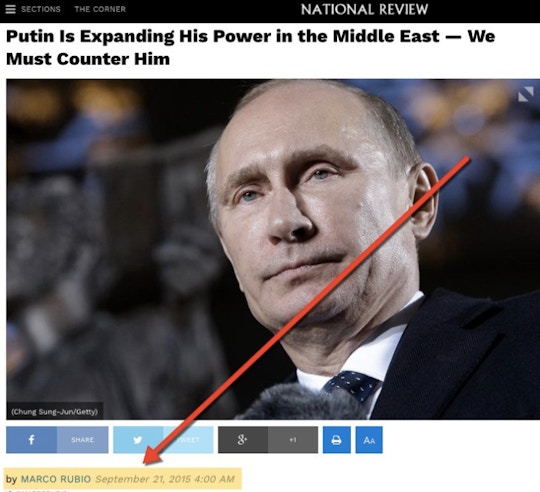While many people are aware that U.S. news reporting on Israel-Palestine is frequently problematic, they’re not always aware that the media are also at times problematic on other issues
A think-tank named Hamilton 68 that spawned hundreds of fraudulent headlines and TV news segments about supposed ‘Russian influence’ may go down as the single greatest case of media fabulism in American history
The Twitter Files reveal that one of the most common news sources of the Trump era was a scam, making ordinary American political conversations look like Russian spywork
The ‘Russian threat’ was largely a bunch of ordinary Americans, dressed up to look like a Red Menace – and the media repeated the scam: NBC, CBS, ABC, PBS, CNN, MSNBC, New York Times, Washington Post, Mother Jones, Politifact, Snopes, etc
Some of those promoting this misinformation were pro-Israel neocons like Michael Chertoff and Bill Kristol, who previously promoted the disastrous Iraq War
This pervasive narrative helped lay the groundwork for the current unnecessary and potentially catastrophic war with Russia
See articles and videos below by top journalists Matt Taibbi, Glenn Greenwald, and others…
[For readers unfamiliar with some of those named in the articles below, IAK has added italicized information in brackets]
Move Over, Jayson Blair: Meet Hamilton 68, the New King of Media Fraud
By Matt Taibbi, reposted from Racket News on Substack
Ambitious media frauds Stephen Glass and Jayson Blair crippled the reputations of the New Republic and New York Times, respectively, by slipping years of invented news stories into their pages. Thanks to the Twitter Files, we can welcome a new member to their infamous club: Hamilton 68.
If one goes by volume alone, this oft-cited neoliberal think-tank that spawned hundreds of fraudulent headlines and TV news segments may go down as the single greatest case of media fabulism in American history. Virtually every major news organization in America is implicated, including NBC, CBS, ABC, PBS, CNN, MSNBC, The New York Times and the Washington Post. Mother Jones alone did at least 14 stories pegged to the group’s “research.” Even fact-checking sites like Politifact and Snopes cited Hamilton 68 as a source.
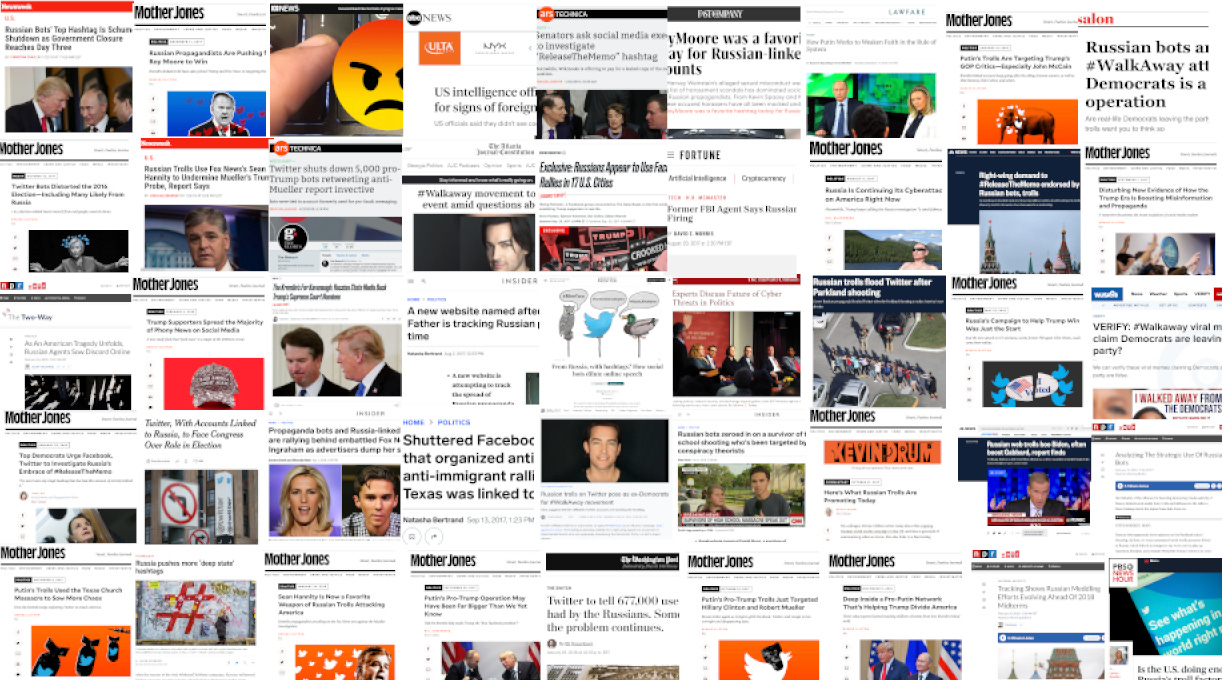
Hamilton 68 was and is a computerized “dashboard” designed to be used by reporters and academics to measure “Russian disinformation.” It was the brainchild of former FBI agent (and current MSNBC “disinformation expert”) Clint Watts, and backed by the German Marshall Fund and the Alliance for Securing Democracy, a bipartisan think-tank. The latter’s advisory panel includes former acting CIA chief Michael Morell, former Ambassador to Russia Michael McFaul, former Hillary for America chair John Podesta, and onetime Weekly Standard [see this regarding its promotion of war] editor Bill Kristol. [The advisory panel also includes Michael Chertoff, former head of Homeland Security, an Israel partisan whose mother was Israeli.]
1.THREAD: Twitter Files #15
MOVE OVER, JAYSON BLAIR: TWITTER FILES EXPOSE NEXT GREAT MEDIA FRAUD pic.twitter.com/bLRpDpuWql— Matt Taibbi (@mtaibbi) January 27, 2023
The Twitter Files expose Hamilton 68 as a sham:
The secret ingredient in Hamilton 68’s analytic method was a list of 644 accounts supposedly linked “to Russian influence activities online.” It was hidden from the public, but Twitter was in a unique position to recreate Hamilton’s sample by analyzing its Application Program Interface (API) requests, which is how they first “reverse-engineered” Hamilton’s list in late 2017.
The company was concerned enough about the proliferation of news stories linked to Hamilton 68 that it also ordered a forensic analysis. Note the second page below lists many of the different types of shadow-banning techniques that existed at Twitter even in 2017, buttressing the “Twitter’s Secret Blacklist” thread by Bari Weiss last month. Here you see categories ranging from “Trends Blacklist” to “Search Blacklist” to “NSFW High Precision.” Twitter was checking to see how many of Hamilton’s accounts were spammy, phony, or bot-like. Note that out of 644 accounts, just 36 were registered in Russia, and many of those were associated with RT.

Twitter executives were shocked at the fraud
Examining further, Twitter execs were shocked. The accounts Hamilton 68 claimed were linked to “Russian influence activities online” were not only overwhelmingly English-language (86%), but mostly “legitimate people,” largely in the U.S., Canada, and Britain. Grasping right away that Twitter might be implicated in a moral outrage, they wrote that these account-holders “need to know they’ve been unilaterally labeled Russian stooges without evidence or recourse.”
Other comments in internal company emails:
“These accounts are neither strongly Russian nor strongly bots.”
“No evidence to support the statement that the dashboard is a finger on the pulse of Russian information ops.”
“Hardly evidence of a massive influence campaign.”
Declared Trust and Safety chief Yoel Roth: “I think we need to just call this out on the bullshit it is.”
The two founders of Hamilton 68, the blue-and-red team of former counselor to Marco Rubio Jamie Fly and Hillary for America Foreign Policy Advisor Laura Rosenberger*, told Politico they couldn’t reveal the names of the accounts because “the Russians will simply shut them down.” Tchya, right. One look at the list reveals the real reason they couldn’t make it public.
This was not faulty science. It was a scam. Instead of tracking how “Russia” influenced American attitudes, Hamilton 68 simply collected a handful of mostly real, mostly American accounts, and described their organic conversations as Russian scheming. As Roth put it, “Virtually any conclusion drawn from [the dashboard] will take conversations in conservative circles on Twitter and accuse them of being Russian.”
There were three major classes of account on the Hamilton list: a thin layer of obvious Russians (e.g. https://twitter.com/RT_America), then the larger pile of real people from Western countries, followed by a percentage — somewhere between a fifth and a third — of “low user state,” “near dead,” “spammy” accounts that didn’t accumulate followers and “do not have a very wide reach on the platform.” Twitter executives observed that the zombie accounts were not amplifying the real accounts. Instead of, say, a group of Russian accounts boosting Trump messaging, it was the reverse — a bunch of real Trump accounts simulating Hamilton’s assertions about Russians.
“The selection of accounts is… bizarre and seemingly quite arbitrary,” wrote Roth. “They appear to strongly preference pro-Trump accounts (which they use to assert that Russia is expressing a preference for Trump… even though there’s not good evidence any of them are Russian).”
Even Twitter execs were stunned to read who was listed. The names ranged from well-known media figures like David Horowitz to conservatives like Dennis Michael Lynch and progressives like Consortium editor Joe Lauria. It’s crucial to understand that the list captured not just Trump supporters but a range of political dissidents, including leftists, anarchists and humorists. Wrote policy chief Nick Pickles, upon seeing the name of British satirist @Holbornlolz:
“A wind-up merchant,” he wrote. “I follow him and wouldn’t say he’s pro-Russian… I can’t even remember him tweeting about Russia.”
These people never knew they were used for years to drive hundreds if not thousands of media headlines about supposed Russian bot infiltration of online discussions: about the Brett Kavanaugh hearings, Tulsi Gabbard’s campaign, the #ReleaseTheMemo affair, the Parkland shooting, Donald Trump’s election, the #WalkAway and #IStandWithLaura hashtags, U.S. missile strikes in Syria, the Bernie Sanders campaign, the “Blexit” movement to peel black voters away from Democrats, calls to fire National Security Advisor H.R. McMaster, “attacks” on the Mueller investigation, and countless other issues.
The supposed “Russian bots”
Last week, I began contacting people on the list. Reactions have rested between blind fury (“Motherfuckers!”) and shock (“I am a 73-year-old snowbird in Florida… how could I be a Russian bot?”), with a few noting that the news was outrageous but unsurprising.
“Sadly, I’m not surprised but I am angered that we are once again falsely accused of spreading ‘Russian disinformation,’ this time on Twitter,” said Consortium’s Lauria. “Organizations like Hamilton 68 are in business to enforce an official narrative, which means excising inconvenient facts, which they call ‘misinformation.’”
“I’ve written a book about the U.S. Constitution,” says Chicago-based lawyer Dave Shestokas. “How I made a list like this is incredible to me.”
“I’m listed as a foreign bot?” says Lynch. “As a proud taxpaying citizen, charitable family man, and honest son of a US Marine w/a Purple Heart, I’m hurt. I deserve better. We all do!”
As a child, Sonia Monsour lived through civil war in Lebanon, in a town that was taken over by a Christian militia. Her father counseled her then to dispose of some leftist books that they kept at home, so that her political beliefs would not be held against her. Upon being told she was on the Hamilton 68 list, she recalled that childhood story. She moved to the West to get away from such problems.
“Supposedly in a free world, we are being watched at many levels, by what we say online,” she said.
Oregon native Jacob Levich (@cordeliers) was one of the few people on the list who knew what Hamilton 68 was. “I recall that it was some sort of spooky NGO that was involved in identifying accounts that were thought to be subversive,” he said. Informed he was on their list, he said, “I can tell you that there is absolutely no sense in which I’m subject to any kind of Russian influence.”
Levich went on:
“When I was growing up, my father told me about the McCarthyite blacklist,” he said. “As a child it would never have occurred to me that this would come back, in force and broadly, and in a way designed to undermine rights we hold dear.”
Levich’s tale is at the heart of what is so sinister about the Hamilton 68 campaign. This was digital McCarthyism, taking people with dissident or unconventional opinions and mass-accusing them of “Un-American activities.” The peculiar twist of the Hamilton 68 version of McCarthyism is that instead of targeting leftists (although there are several self-professed left-leaning accounts on the list), the bulk of the real accounts involved conservatives, with handles like ULTRA MAGA Dog Mom and @ClassyLadyForDJT.
Even at Twitter, where there were basically no open conservatives in the email record, it was recognized that Hamilton 68 (and at least two other research institutes using similar methodology) were simply taking organic Trumpish chatter and describing it as Russian scheming.
The site “falsely accuses a bunch of legitimate right-leaning accounts of being Russian bots,” as Roth put it, getting “traction around partisan trends, to assert that any right-leaning content is propagated by Russian bots.”
Universities & Congressional reps promote the fraud
This was an academic scandal as well, as Harvard, Princeton, Temple, NYU, GWU, and other universities promoted Hamilton 68 as a source. Perhaps most embarrassingly, multiple elected officials promoted the site. Dianne Feinstein, James Lankford, Richard Blumenthal, Adam Schiff, and Mark Warner were among the offenders. Watts, who clearly knew how to play up the melodrama of his role, gave dire warnings to the Senate Intelligence Committee, telling them they should “follow the dead bodies” if they wanted to get to the bottom of the Russian interference problem.
Though it is easy to see how it could be infuriating to be put on such a list — one veteran I spoke with had to leave the room and take a deep breath before coming back to the phone — the broader damage was to society, which was subject to near-daily news reports using this “The Russian Bots Are Coming” format.
The scam harmed Sanders, Trump, Gabbard – Helped Biden
These stories are still having a huge impact on American culture and politics and played significant roles in the 2018 and 2020 election cycles, placing downward pressure on the Sanders, Trump and Gabbard campaigns while boosting the likes of Joe Biden (frequently depicted as a “target” of Russian bots). In the wake of any online controversy, be it the Colin Kaepernick saga or gun control debates after mass shootings, reporters raced to claim “Russian bots” were trying to “sow division,” often using Hamilton or an outfit like it to bolster their claims.
Worse, the site pioneered a new form of fake news, which reporters at organizations like Mother Jones, the Washington Post, CNN and MSNBC ate up for two reasons. One, they tended to be politically simpatico with the site’s conclusions (the Daily Beast didn’t need a push to claim Russian bots were pushing Trump flash mobs “in 17 cities”). Two, it was easy content.
“Here’s what Russian trolls are promoting today,” read a piece in Mother Jones by Kevin Drum, all but announcing that reporters could make headlines as quickly as instant coffee in the Ham68 age.
By early 2018 — perhaps after a talk with Twitter, whose execs pondered the upside of “educating Clint” — Watts was publicly questioning his own methodology, saying, “I’m not convinced on this bot thing.” Not long after, another key figure associated with Hamilton 68, Jonathon Morgan of the “cyber security firm” New Knowledge, was outed for faking a Russian influence operation in the Alabama Senate Race. He used Hamilton-like tactics to create online chatter about Republican Roy Moore having Russian bot support, got caught, and suffered the indignity of having what he called a “small experiment” described as a “false flag” operation in the New York Times.
Even after his “experiment” was outed, and even after Watts expressed doubts about the “bot thing,” the flood of “Here come the bots” news stories continued. News organizations had fallen in love with a new trick: research institute makes invented bot claims, reporters toss said claims at hated targets like Devin Nunes or Tulsi Gabbard, headlines flow. The scam needed just three elements: credentials of someone like “former FBI agent” Watts, the absence of any semblance of fact-checking, and the silence of companies like Twitter.
On the third point, Twitter is not guiltless. Though people like Roth wanted to go hard at the fabulists — “My recommendation at this stage is an ultimatum: you release the list or we do,” he wrote — ultimately people like future White House and National Security Council spokeswoman Emily Horne advised caution. “We have to be careful in how much we push back on ASD publicly,” she wrote. Carlos Monje, future senior advisor to Transportation Secretary Pete Buttigieg, concurred.
“I also have been very frustrated in not calling out Hamilton 68 more publicly, but understand we have to play a longer game here,” Monje decided.
Even if Twitter had pushed back, it wouldn’t have mattered. As it was, when company spokespeople urged reporters off the record to stay away, they didn’t — just as Senators Dianne Feinstein and Richard Blumenthal didn’t, when Twitter tried to warn them that “Russian bot” stories were fake. Horne wrote several times that she had no luck in steering journalists away from these hack headlines. “Reporters are chafing,” she wrote, adding, “it’s like shouting into a void.”
MSNBC, Politico, Mother Jones, Washington Post pretend it didn’t happen
I asked for comment from a huge range of actors — from the Alliance for Securing Democracy to Watts and McFaul and Podesta and Kristol to editors and news directors at MSNBC, Politico, Mother Jones, the Washington Post, Politifact, and others. Not one answered. They’re all going to pretend this didn’t happen. The few reporters who got this right contemporaneously, from Glenn Greenwald to Max Blumenthal to Miriam Elder and Charlie Wurzel of Buzzfeed to sites like Moon of Alabama, can take a victory lap. Almost every other news organization ran these stories and needs to come clean about it.
The Hamilton 68 tale has no clear analog in media history, which may give mainstream media writers an excuse not to cover it. They will be under heavy pressure to avoid addressing this scandal, since nearly all of them work for organizations guilty of spreading Hamilton’s “bullshit” stories in volume.
This is one of the more significant Twitter Files stories. Each one of these tales explains something new about how companies like Twitter came to lose independence. In the U.S., the door was opened for agencies like the FBI and DHS to press on content moderation after Congress harangued Twitter, Facebook, and Google about Russian “interference,” a phenomenon that had to be seen as an ongoing threat in order to require increased surveillance. “I do very much believe America is under attack,” is how Hamilton 68 co-founder Laura Rosenberger put it, after watching the tweets of Sonya Monsour, David Horowitz, and @holbornlolz.
The Hamilton 68 story shows how the illusion of ongoing “Russian interference” worked. The magic trick was generated via a confluence of interests, between think-tanks, media, and government. Before, we could only speculate. Now we know: the “Russian threat” was, in this case at least, just a bunch of ordinary Americans, dressed up to look like a Red Menace. Jayson Blair had a hell of an imagination, but even he couldn’t have come up with a scheme this obscene. Shame on every news outlet that hasn’t renounced these tales.
“Outfits like Hamilton 68 don’t have to agree with us,” says Lauria. “But they should just leave us the hell alone.”
Hamilton 68: Brief Addendum
By Matt Taibbi, reposted from Racket
Hamilton 68 responded to a #TwitterFiles thread Friday with a series of claims, including that their site was always intended to be understood as “nuanced,” that they always maintained that “witting or unwitting” accounts could be on their list, and that “some accounts we track are automated bots, some are trolls, and some are real users.”
They could also have inserted the disclaimer added to the new Hamilton 2.0 page, which as a helpful reader noted this morning, includes in red font a blaring warning to all that it would be INCORRECT to label anyone or anything that appears on their dashboard “as being connected to state-backed propaganda”:

Thank heaven for the Wayback Machine. Here’s what was written on the original Hamilton page:
These accounts were selected for their relationship to Russian-sponsored influence and disinformation campaigns, and not because of any domestic political content.
We have monitored these datasets for months in order to verify their relevance to Russian disinformation programs targeting the United States.
…this will provide a resource for journalists to appropriately identify Russian-sponsored information campaigns.
High on that original page, the Hamilton founders explained they monitored two types of accounts:
There are two components to the dashboard featured here.
The first section, “Overt Promotion of Content,” highlights trending content from Twitter accounts for media outlets known to be controlled by the Russian government.
The second section, “Content Tweeted by Bots and Trolls,” highlights themes being pushed by Twitter accounts linked to Russian influence campaigns.
The Hamilton list tracked overt Russian media on the one hand, and “bots and trolls” on the other. Note the difference between that language and the language Friday: “Some accounts we track are automated bots, some are trolls, and some are real users.” That Hamilton Friday was also trying to distance itself from headlines about “bots” is particularly grotesque, given that it was so overt in identifying the composition of its list this way at the start.
I encourage everyone to read language from the original site, then look at Friday’s ironically named “Fact sheet,” and compare for yourselves.
Finally I want to note a passage from the Friday “fact sheet” I somehow overlooked:
Individual accounts were algorithmically selected based on analytic techniques developed by J.M. Berger that were used to identify the most influential accounts within those networks. The Hamilton 68 team did not individually review or verify all accounts because the focus of the dashboard was to analyze behavior in aggregate networks, not specific accounts.
Translating: individual accounts were chosen through a method developed by J.M. Berger, a writer and think-tanker whose usual specialty is extremism (he’s written about ISIS and domestic white nationalism in the U.S.). Still, it wasn’t even Berger’s fault that ordinary Americans ended up in the list, since said people were chosen “algorithmically.” The Hamilton 68 team also “did not individually review or verify” all the names, because their “focus” was “aggregate networks,” not “specific accounts.”
So, nobody looked at the list.
The list that was “the fruit of more than three years of observation and monitoring.”’
Sounds solid.
Yes? No?
With New D.C. Policy Group, Dems Continue to Rehabilitate and Unify With Bush-Era Neocons
By Glenn Greenwald, reposted from The Intercept, July 17, 2017
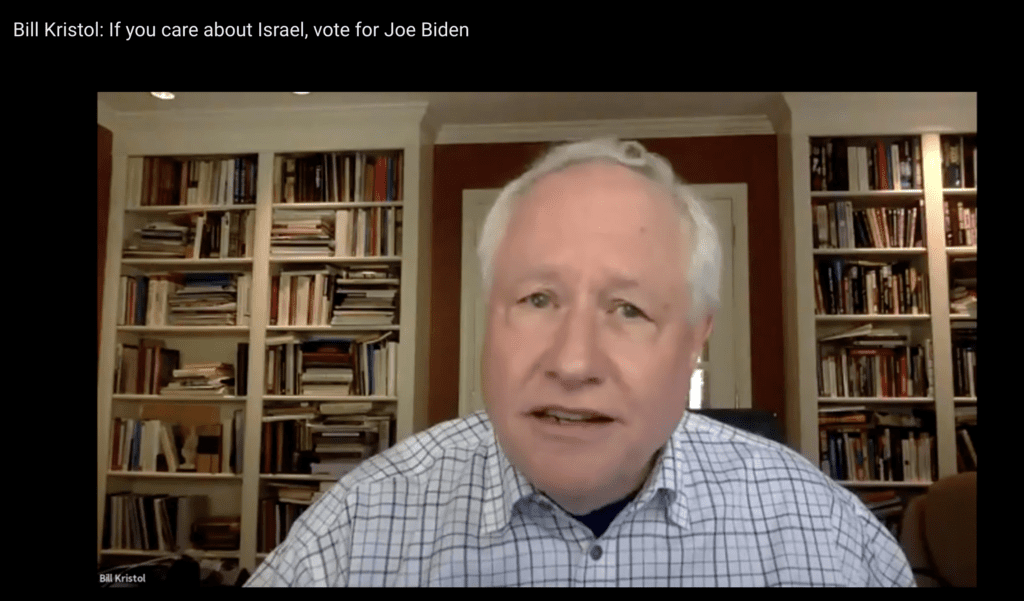
Journalist Glenn Greenwald may have been the first analyst to expose “Alliance for Securing Democracy,” the group behind Hamilton 68. In 2017 he wrote:
A newly formed advocacy group devoted to hawkish U.S. policies toward Russia brings together the Democratic Party & and the country’s most extreme and discredited neocons…
Leading Democratic Party foreign policy officials are willing to form new Beltway advocacy groups in collaboration with those who caused the invasion of Iraq and tried to launch a bombing campaign against Tehran
Neocons were among the earliest and most vocal GOP opponents of Trump. They viewed him as an ideological threat to their orthodoxies, such as when he advocated for U.S. “neutrality” on the Israel/Palestine conflict and railed against the wisdom of the wars in Iraq and Libya…
One of the most under-discussed yet consequential changes in the American political landscape is the reunion between the Democratic Party and the country’s most extreme and discredited neocons. While the rise of Donald Trump, whom neocons loathe, has accelerated this realignment, it began long before the ascension of Trump and is driven by far more common beliefs than contempt for the current president.
A newly formed and, by all appearances, well-funded national security advocacy group, devoted to more hawkish U.S. policies toward Russia and other adversaries, provides the most vivid evidence yet of this alliance. Calling itself the Alliance for Securing Democracy, the group describes itself as “a bipartisan, transatlantic initiative” that “will develop comprehensive strategies to defend against, deter, and raise the costs on Russian and other state actors’ efforts to undermine democracy and democratic institutions,” and also “will work to publicly document and expose Vladimir Putin’s ongoing efforts to subvert democracy in the United States and Europe.”
It is, in fact, the ultimate union of mainstream Democratic foreign policy officials and the world’s most militant, and militaristic, neocons. The group is led by two longtime Washington foreign policy hands, one from the establishment Democratic wing and the other a key figure among leading GOP neocons.
The Democrat, Laura Rosenberger, served as a foreign policy adviser for Hillary Clinton’s 2016 presidential campaign and chief of staff to two Obama national security officials. [Jewish Journal reports that Rosenberger grew up in a strongly pro-Israel environment, traveling to Israel with Young Judea and spending summer each year at Emma Kaufmann Camp, known for celebrating “Israel Day.”]
The Republican is Jamie Fly, who spent the last four years as counselor for foreign and national security affairs to one of the Senate’s most hawkish members, Marco Rubio [One of the Senate’s most consistent Israel advocates, funded by pro-Israel billionaires]; prior to that, he served in various capacities in the Bush Pentagon and National Security Council.
Jamie Fly closely tied to Kristol
Fly’s neocon pedigree is impressive indeed. During the Obama years, he wrote dozens of articles for the Weekly Standard — some co-authored with Bill Kristol himself — attacking Obama for insufficient belligerence toward Iran and terrorists generally, pronouncing Obama “increasingly ill suited to the world he faces as president” by virtue of his supposed refusal to use military force frequently enough (Obama bombed seven predominantly Muslim countries during his time in office, including an average of 72 bombs dropped per day in 2016 alone).
The Democrats’ new partner Jamie Fly spent 2010 working in tandem with Bill Kristol urging military action — i.e., aggressive war — against Iran. In a 2010 Weekly Standard article co-written with Kristol, Fly argued that “the key to changing [Iran’s thinking about its nuclear program] is a serious debate about the military option,” adding: “It’s time for Congress to seriously explore an Authorization of Military Force to halt Iran’s nuclear program.”
Fly then went around the D.C. think tank circuit, under the guise of advocating “debate,” espousing the need to use military force against Iran, spouting standing neocon innuendo such as “we need to be wary of the Obama administration’s intentions” toward Iran. He mocked Obama officials, and Bush officials before them, for their “obsession with diplomatic options” to resolve tensions with Iran short of war. The Kristol/Fly duo returned in 2012 to more explicitly argue: “Isn’t it time for the president to ask Congress for an Authorization for Use of Military Force against Iran’s nuclear program?”
Beyond working as Rubio’s foreign policy adviser, Fly was the executive director of “the Foreign Policy Initiative,” a group founded by Kristol along with two other leading neocons, Robert Kagan [see this] and Dan Senor [see this and this], who was previously the chief spokesman for the Coalition Provisional Authority in Iraq. That group is devoted to standard neocon agitprop, demanding “a renewed commitment to American leadership” on the ground that “the United States remains the world’s indispensable nation.” In sum, as Vox’s Dylan Matthews put it during the 2016 campaign, “If you want a foreign policy adviser with strong ties to the neocon world, it’s hard to do better than Fly.”

When it comes to this new group, the alliance of Democrats with the most extreme neocon elements is visible beyond the group’s staff leadership. Its board of advisers is composed of both leading Democratic foreign policy experts, along with the nation’s most extremist neocons.
Thus, alongside Jake Sullivan (national security adviser to Joe Biden and the Clinton campaign), Mike Morrell (Obama’s acting CIA director) and Mike McFaul (Obama’s ambassador to Russia) sit leading neocons such as Mike Chertoff (Bush’s homeland security secretary), Mike Rogers (the far-right, supremely hawkish former congressman who now hosts a right-wing radio show); and Bill Kristol himself.
In sum — just as was true of the first Cold War, when neocons made their home among the Cold Warriors of the Democratic Party — on the key foreign policy controversies, there is now little to no daylight between leading Democratic Party foreign policy gurus and the Bush-era neocons who had wallowed in disgrace following the debacle of Iraq and the broader abuses of the war on terror. That’s why they are able so comfortably to unify this way in support of common foreign policy objectives and beliefs.
DEMOCRATS OFTEN JUSTIFY this union as a mere marriage of convenience: a pragmatic, temporary alliance necessitated by the narrow goal of stopping Trump. But for many reasons, that is an obvious pretext, unpersuasive in the extreme. This Democrat/neocon reunion had been developing long before anyone believed Donald Trump could ascend to power, and this alliance extends to common perspectives, goals, and policies that have little to do with the current president.
It is true that neocons were among the earliest and most vocal GOP opponents of Trump. That was because they viewed him as an ideological threat to their orthodoxies (such as when he advocated for U.S. “neutrality” on the Israel/Palestine conflict and railed against the wisdom of the wars in Iraq and Libya), but they were also worried that his uncouth, offensive personality would embarrass the U.S. and thus weaken the “soft power” needed for imperial hegemony. Even if Trump could be brought into line on neocon orthodoxy — as has largely happened — his ineptitude and instability posed a threat to their agenda.
But Democrats and neocons share far more than revulsion toward Trump; particularly once Hillary Clinton became the party’s standard-bearer, they share the same fundamental beliefs about the U.S. role in the world and how to assert U.S. power. In other words, this alliance is explained by far more than antipathy to Trump.
Indeed, the likelihood of a neocon/Democrat reunion long predates Trump. Back in the summer of 2014 — almost a year before Trump announced his intent to run for president — longtime neocon-watcher Jacob Heilbrunn, writing in the New York Times, predicted that “the neocons may be preparing a more brazen feat: aligning themselves with Hillary Rodham Clinton and her nascent presidential campaign, in a bid to return to the driver’s seat of American foreign policy.”
Noting the Democratic Party’s decades-long embrace of the Cold War belligerence that neocons love most — from Truman and JFK to LBJ and Scoop Jackson — Heilbrunn documented the prominent neocons who, throughout Clinton’s tenure as secretary of state, were heaping praise on her and moving to align with her. Heilbrunn explained the natural ideological affinity between neocons and establishment Democrats:
“And the thing is, these neocons have a point,” he wrote. “Mrs. Clinton voted for the Iraq war; supported sending arms to Syrian rebels; likened Russia’s president, Vladimir V. Putin, to Adolf Hitler; wholeheartedly backs Israel; and stresses the importance of promoting democracy.”
One finds evidence of this alliance long before the emergence of Trump. Victoria Nuland, for instance, served as one of Dick Cheney’s top foreign policy advisers during the Bush years. Married to one of the most influential neocons, Robert Kagan, Nuland then seamlessly shifted into the Obama State Department and then became a top foreign policy adviser to the Clinton campaign.
As anti-war sentiment grew among some GOP precincts — as evidenced by the success of the Ron Paul candidacies of 2008 and 2012, and then Trump’s early posturing as an opponent of U.S. interventions — neocons started to conclude that their agenda, which never changed, would be better advanced by realignment back into the Democratic Party. Writing in The Nation in early 2016, Matt Duss detailed how the neocon mentality was losing traction within the GOP, and predicted:
Yet another possibility is that the neocons will start to migrate back to the Democratic Party, which they exited in the 1970s in response to Vietnam-inspired anti-interventionism. That’s what earned their faction the “neo” prefix in the first place. As Nation contributor James Carden recently observed, there are signs that prominent neocons have started gravitating toward Hillary Clinton’s campaign. But the question is, Now that the neocons has been revealed as having no real grassroots to deliver, and that their actual constituency consists almost entirely of a handful of donors subsidizing a few dozen think tankers, journalists, and letterheads, why would Democrats want them back?
The answer to that question — “why would Democrats want them back?” — is clear: because, as this new group demonstrates, Democrats find large amounts of common cause with neocons when it comes to foreign policy.
The neocons may be migrating back to the Democratic Party and into the open embrace of its establishment, but their homecoming will not be a seamless affair: Duss, for instance, is now the top foreign policy adviser to Sen. Bernie Sanders. After spending little energy on foreign affairs as a candidate, Sanders’s hiring of Duss is a sign that he sees a rejection of interventionism as ascendant with the populist element of the party.
He will have allies there from whatever is left of the faction within the Obama administration which willingly took so much heat from the foreign policy establishment for its insufficient aggression toward Russia or other perceived enemies; Sen. Chris Murphy, for instance, has been vocal in his opposition to arming the Saudis as they savage Yemen. But now that hawkish rhetoric and belligerent policies have subsumed the Democrats, it remains to be seen how much of that anti-interventionism survives.
FOR MANY YEARS — long before the 2016 election — one of the leading neocon planks was that Russia and Putin pose a major threat to the west, and Obama was far too weak and deferential to stand up to this threat. From the start of the Obama presidency, the Weekly Standard warned that Obama failed to understand, and refused to confront, the dangers posed by Moscow. From Ukraine to Syria, neocons constantly attacked Obama for letting Putin walk all over him.
That Obama was weak on Russia, and failing to stand up to Putin, was a major attack theme for the most hawkish GOP senators such as Rubio and John McCain. Writing in National Review in 2015, Rubio warned that Putin was acting aggressively in multiple theaters, but “as the evidence of failure grows, President Obama still can’t seem to understand Vladimir Putin’s goals.” Rubio insisted that Obama (and Clinton’s) failure to confront Putin was endangering the West:
In sum, we need to replace a policy of weakness with a policy of strength. We need to restore American leadership and make clear to our adversaries that they will pay a significant price for aggression. President Obama’s policies of retreat and retrenchment are making the world a more dangerous place. The Obama-Clinton Russia policy has already undermined European security. We can’t let Putin wreak even more havoc in the Middle East.
In 2015, Obama met with Putin at the U.N. General Assembly, and leading Republicans excoriated him for doing so. Obama “has in fact strengthened Putin’s hand,” said Rubio. McCain issued a statement denouncing Obama for meeting with the Russian tyrant, accusing him of failing to stand up to Putin across the world:
That Putin was a grave threat, and Obama was too weak in the face of it, was also a primary theme of Jeb Bush’s presidential campaign:
And even back in 2012, Mitt Romney repeatedly accused Obama of being insufficiently tough on Putin, prompting the now-infamous mockery by Obama and Democrats generally of Romney’s Russiaphobia, which they ridiculed as an ancient relic of the Cold War. Indeed, before Trump’s emergence, the hard-core pro-GOP neocons planned to run against Hillary Clinton by tying her to the Kremlin and warning that her victory would empower Moscow:
Even through the 2016 election, McCain and Rubio repeatedly attacked Obama for failing to take Russian hacking seriously enough and for failing to retaliate. And for years before that, Russia was a primary obsession for neocons, from the time it went to war with Georgia (at the time headed by a neocon-loved president) and even prior to that.
Thus, when it came time for Democrats to elevate Putin and Russia into a major theme of the 2016 campaign, and now that their hawkishness toward Moscow is their go-to weapon for attacking Trump, neocons have become their natural ideological allies.
The song Democrats are now singing about Russia and Putin is one the neocons wrote many years ago, and all of the accompanying rhetorical tactics — accusing those who seek better relations with Moscow of being Putin’s stooges, unpatriotic, of suspect loyalties, etc. — are the ones that have defined the neocons smear campaigns for decades.
The union of Democrats and neocons is far more than a temporary marriage of convenience designed to bring down a common enemy. As this new policy group illustrates, the union is grounded in widespread ideological agreement on a broad array of foreign policy debates: from Israel to Syria to the Gulf States to Ukraine to Russia. And the narrow differences that exist between the two groups — on the wisdom of the Iran deal, the nobility of the Iraq War, the justifiability of torture — are more relics of past debates than current, live controversies. These two groups have found common cause because, with rare and limited exception, they share common policy beliefs and foreign policy mentalities.
THE IMPLICATIONS OF this reunion are profound and long-term. Neocons have done far more damage to the U.S., and the world, than any other single group — by a good margin. They were the architects of the invasion of Iraq and the lies that accompanied it, the worldwide torture regime instituted after 9/11, and the general political climate that equated dissent with treason.
- Israel loyalists embedded in U.S. government pushed U.S. into Iraq War
- Pentagon officer described how Israelists manufactured anti-Iraq disinfo that led to war
With the full-scale discrediting and collapse of the Bush presidency, these war-loving neocons found themselves marginalized, without any constituency in either party. They were radioactive, confined to speaking at extremist conferences and working with fringe organizations.
All of that has changed, thanks to the eagerness of Democrats to embrace them, form alliances with them, and thus rehabilitate their reputations and resurrect their power and influence. That leading Democratic Party foreign policy officials are willing to form new Beltway advocacy groups in collaboration with Bill Kristol, Mike Rogers, and Mike Chertoff, join arms with those who caused the invasion of Iraq and tried to launch a bombing campaign against Tehran, has repercussions that will easily survive the Trump presidency.
Perhaps the most notable fact about the current posture of the establishment wing of the Democratic Party is that one of their favorite, most beloved, and most cited pundits is the same neocon who wrote George W. Bush’s oppressive, bullying and deceitful speeches in 2002 and 2003 about Iraq and the war on terror, and who has churned out some of the most hateful, inflammatory rhetoric over the last decade about Palestinians, immigrants, and Muslims.
That Bush propagandist, David Frum [another Israel partisan – see this and this], is regularly feted on MSNBC’s liberal programs, has been hired by The Atlantic (where he writes warnings about authoritarianism even though he’s only qualified to write manuals for its implementation), and is treated like a wise and honored statesman by leading Democratic Party organs.
One sees this same dynamic repeated with many other of the world’s most militaristic, war-loving neocons. Particularly after his recent argument with Tucker Carlson over Russia, Democrats have practically canonized Max Boot, who has literally cheered for every possible war over the two past decades and, in 2013, wrote a column titled “No Need to Repent for Support of Iraq War.” It is now common to see Democratic pundits and office holders even favorably citing and praising Bill Kristol himself.
There’s certainly nothing wrong with discrete agreement on a particular issue with someone of a different party or ideology; that’s to be encouraged. But what’s going on here goes far, far beyond that.
What we see instead are leading Democratic foreign policy experts joining hands with the world’s worst neocons to form new, broad-based policy advocacy groups to re-shape U.S. foreign policy toward a more hostile, belligerent and hawkish posture. We see not isolated agreement with neocons in opposition to Trump or on single-issue debates, but a full-scale embrace of them that is rehabilitating their standing, empowering their worst elements, and reintegrating them back into the Democratic Party power structure.
If Bill Kristol and Mike Chertoff can now sit on boards with top Clinton and Obama policy advisers, as they’re doing, that is reflective of much more than a marriage of convenience to stop an authoritarian, reckless president. It demonstrates widespread agreement on a broast range of issues and, more significantly, the return of neocons to full-scale D.C. respectability, riding all the way on the backs of eager, grateful establishment Democrats.
Episode 23: “America This Week,” with Matt Taibbi and Walter Kirn – Discuss Hamilton 68:
From Racket News
Tucker examines the Hamilton 68 ‘Russian disinformation’ tracker:
Massive Resistance Scam Exposed
Begin viewing video below at about 31:40:
RELATED:
- John Mearsheimer & Ray McGovern: Essential info on Ukraine-Russia
- The Israel Factor in Neocons’ Anti-Russia Warmongering over Ukraine
- WATCH: Chomsky says Israel, not Russia, Interferes with US Elections
- WATCH: Stephen Cohen: Right now, we are in a new cold war
-
Pro-Israel, Pro-War Neocons ally with “Progressives” to Destroy Donald Trump




